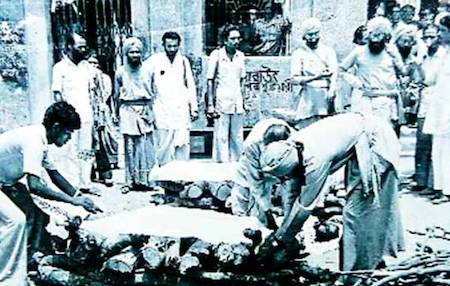Political violence has always been part of West Bengal history. Over the period, it has just mutated and transformed itself. Kolkata, then known as Calcutta, became as violent a city as Mumbai was known to be in the latter half of the 20th century.
In West Bengal, in the three decades that it was in power, the Communists have inflicted violence on the common people, especially those who have politically opposed them.
The cult of violence is their creed and whenever a moment present itself, they never fail to resort to it.
During the Left Front regime, the cataclysmic violence lessened and political violence became ‘normal’. Or to put it differently, what we can describe as violence became banal. All forms of social violence seem to have been subsumed in political violence.
The rule of Communists in West Bengal was one of the bloodiest episodes in democratic India’s history. The three decades of communist reign in West Bengal has been a nightmare for the Hindus of the state as the attacks on them soon became “normal”.
It was not long back when two Sadhus were lynched brutally in Palghar, Maharashtra and the entire nation went into shock but it is extremely unfortunate to know that this was not the first time that the country was forced to witness such morbidity.
There is another incident that occurred thirty-eight years ago that rivals the brutal Palghar lynching in its brutality, if not exceed it. Over the years, that incident has come to be known as the Bijon Setu Massacre.
On April 30, 1982, when the CPM-led Left Front was in power in West Bengal, 16 monks and one sanyasin of the Ananda Marga were massacred in broad daylight in the heart of Calcutta.
Anandamargi sanyasis from all over the country were headed for an educational conference held at their headquarters in Tiljala, Calcutta. The taxis carrying monks and sanyasins were intercepted at least three separate locations, doused in petrol and kerosene, and set on fire. At least 17 Margis were charred to death, several others were severely injured.
Shockingly, to date, the government has not arrested a single person in the matter. The CPM Government led by Jyoti Basu set up a commission of inquiry that did not proceed beyond its notification and did not have a single hearing. There are no reports of action taken apart from setting up a commission. The Chief Minister Jyoti Basu infamously said, “What can be done? Such things do happen”, and appeared to issue a veiled threat, wanting to know what consequences might have followed had Sachin Sen, the then CPM MLA of Kasba, chosen to raid the Margis’ center with 10,000 of his cadres.
Some reports also made rounds during that time that suggested that the monks were lynched because they were suspected of kidnapping the children but later, the claim turned out to be baseless as no single case or FIR was registered in that matter.
Even the National Human Rights Commission was set up to investigate the matter but it couldn’t do much because of continuous interference from Jyoti Basu’s government.
Amid all this, an IAS officer of West Bengal Sher Singh, who was the additional district magistrate of 24 Parganas at the time of the incident, came forward and revealed that he was later on suspended from the investigation because he refused to follow the rules of Communist government.
Ananda Margis was ideologically opposed to the communists, and the CPM of the early 80s was deeply suspicious of their activities. The first attack on the Margis occurred in 1967 at its Purulia Global Headquarters where five of them were murdered allegedly by the cadres of CPI(M). The CPM always believed that there are political ambitions and agenda which lay underneath the spiritual-religious cover of the Margis. The Marxists had feared the Margis would upstage their domination in the Kasba belt, which was at that time a base for the CPI(M).
Not only the government but the media also was equally indifferent towards the brutal incident. “Seventeen Ananda Margis, two of them women, were shot to death on April 30 morning by frenzied mobs at three places in South Calcutta on the suspicion that they were child-lifters,” was how The Statesman weekly covered the cold-blooded crime a week later.
Three decades have passed but even today nobody has the answer as to how such spontaneous action can be done at three different places without any planning?


